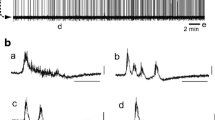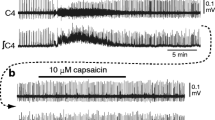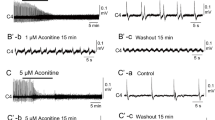Abstract
Effects of 5-hydroxytryptamine (5-HT) on inspiration-related nerve activity and membrane potential of respiratory neurons in the ventrolateral medulla were studied in brainstem-spinal cord preparations isolated from newborn rats. Bath application of 5–100 μM 5-HT induced a biphasic response in inspiratory nerve activity: a transient increase in respiratory frequency followed by a decrease in the rate of discharge. The excitatory effect of 5-HT was particularly prominent in preparations with a respiratory rate of less than 3 min–1, whereas the inhibitory effect was more pronounced in preparations with a higher respiratory rate. In pre-inspiratory (Pre-I) and inspiratory (Insp) neurons, 20 μM 5-HT induced a membrane depolarization of up to 10 mV accompanied by a significant decrease in the input resistance. Membrane depolarization by 5-HT was also evident in the presence of tetrodotoxin. In Pre-I neurons, 5-HT caused an increase in the burst rate, which was followed by a decrease in the intraburst firing frequency and burst amplitude, although the burst rate remained high. The burst rate in Insp neurons first increased and subsequently decreased without significant change in the intraburst firing frequency. Simultaneous intra- and extracellular recordings (in the contralateral medulla) of Pre-I/Pre-I neuron or Pre-I/Insp neuron pairs revealed that 5-HT disturbed the correlation between these neuron bursts. Increase in the respiratory rate induced by 20 μM 5-HT was completely blocked by pretreatment (5–15 min) with 5 μM ketanserin or 1 μM methysergide, but not by 10 μM propranolol. None of these antagonists blocked the inhibitory effects of 5-HT. A 5-HT2 agonist, 1-(2,5-dimethoxy-4-iodophenyl)-2-aminopropane (DOI, 10–100 μM) increased the respiratory rate. Perfusion with a 5-HT1A agonist, 8-hydroxy-dipropylaminotetralin hydrobromide (8-OH-DPAT, 20–100 μM) induced an increase or a decrease in the respiratory rate. A 5-HT2C agonist, 1-(3-chlorophenyl)piperazine (m-CPP, 2–10 μM) induced an initial decrease in the respiratory rate followed by a further long- lasting decrease. Burst activity of Pre-I neurons was suppressed upon administration of 10 μM m-CPP and enhanced with 20 μM DOI. The results suggest that changes in the bursting properties of Pre-I and Insp neurons induced by 5-HT lead to modulation of the respiratory network, thus causing biphasic modulation of the respiratory rhythm. In addition to effects via 5-HT1A receptors, activation of 5-HT2A and 5-HT2C receptor subtypes might be involved in excitatory effects and inhibitory effects of 5-HT respectively.
Similar content being viewed by others

Author information
Authors and Affiliations
Additional information
Received: 1 August 1997 / Received after revision: 27 October 1997 / Accepted: 4 November 1997
Rights and permissions
About this article
Cite this article
Onimaru, H., Shamoto, A. & Homma, I. Modulation of respiratory rhythm by 5-HT in the brainstem-spinal cord preparation from newborn rat. Pflügers Arch 435, 485–494 (1998). https://doi.org/10.1007/s004240050543
Issue Date:
DOI: https://doi.org/10.1007/s004240050543



